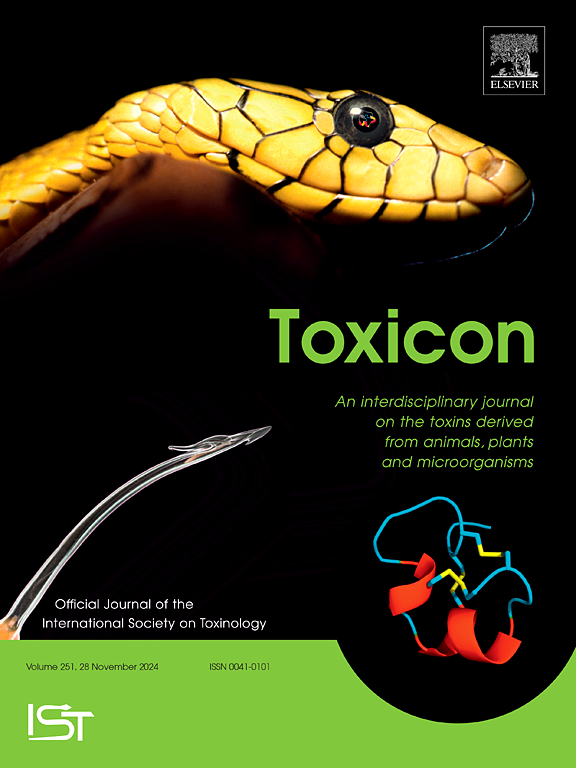Analysis of Naja kaouthia snake venom composition and in-vitro enzymatic activities of 29 specimens in captivity: Highlighting the importance of individual variation in venom pool production
IF 2.6
4区 医学
Q2 PHARMACOLOGY & PHARMACY
引用次数: 0
Abstract
Naja kaouthia is a medically important snake, widely distributed throughout Southeast Asia, with a diverse venom composition. N. kaouthia venom is subject to significant intraspecific variation, caused by several factors, such as the wide geographic distribution of the species, sexual and ontogenetic factors. However, individual variation is a factor that has only been studied with small sample size groups and/or with pooled samples. With this in mind, this study evaluates the composition and in-vitro enzymatic activities of 29 individual venom samples from specimens born in captivity, with a similar genetic background caused by inbreeding, using SDS-PAGE under reducing conditions, RP-HPLC profiles and enzymatic activities of PLA2, LAAO and proteolytic activity over azocasein. Even in this scenario, we were able to observe significant variations in abundance and activity of PLA2. Individual variations in LAAO activity, as well as a sexual dimorphism in which males present a significantly higher LAAO activity than females were observed. Phosphodiasterase and CRiSP abundance were also found and considered to have multiple effects in the clinical manifestations of envenomation by presenting synergistic effects with other proteins from N. kaouthia venom. The RP-HPLC profiles were better at detecting compositional differences than SDS-PAGE profiles and better correlated with enzymatic activities, being a better technique to screen variation profiles and reinforcing the importance of individual venom analysis prior to pooling.

分析人工饲养的 29 条 Naja kaouthia 蛇的毒液成分和体外酶活性:强调毒液池生产中个体差异的重要性。
Naja kaouthia 是一种具有重要医疗价值的蛇类,广泛分布于东南亚各地,其毒液成分多种多样。N. kaouthia 毒液的种内变异很大,这是由多种因素造成的,如该物种广泛的地理分布、性因素和个体发育因素。然而,个体差异这一因素只在样本量较小的群体和/或集合样本中进行过研究。有鉴于此,本研究使用还原条件下的 SDS-PAGE、RP-HPLC 图谱和 PLA2、LAAO 的酶活性以及偶氮酪蛋白的蛋白水解活性,评估了 29 个个体毒液样本的成分和体外酶活性。即使在这种情况下,我们也能观察到 PLA2 的丰度和活性存在显著差异。我们还观察到 LAAO 活性的个体差异,以及雄性 LAAO 活性明显高于雌性的性别二态性。此外,还发现了磷脂酶和 CRiSP 的丰度,并认为它们与 N. kaouthia 毒液中的其他蛋白质具有协同作用,从而对毒液中毒的临床表现产生多重影响。与 SDS-PAGE 图谱相比,RP-HPLC 图谱能更好地检测出成分差异,并与酶活性更好地相关,是筛选变异图谱的一种更好的技术,并加强了在汇集毒液之前进行个体毒液分析的重要性。
本文章由计算机程序翻译,如有差异,请以英文原文为准。
求助全文
约1分钟内获得全文
求助全文
来源期刊

Toxicon
医学-毒理学
CiteScore
4.80
自引率
10.70%
发文量
358
审稿时长
68 days
期刊介绍:
Toxicon has an open access mirror Toxicon: X, sharing the same aims and scope, editorial team, submission system and rigorous peer review. An introductory offer Toxicon: X - full waiver of the Open Access fee.
Toxicon''s "aims and scope" are to publish:
-articles containing the results of original research on problems related to toxins derived from animals, plants and microorganisms
-papers on novel findings related to the chemical, pharmacological, toxicological, and immunological properties of natural toxins
-molecular biological studies of toxins and other genes from poisonous and venomous organisms that advance understanding of the role or function of toxins
-clinical observations on poisoning and envenoming where a new therapeutic principle has been proposed or a decidedly superior clinical result has been obtained.
-material on the use of toxins as tools in studying biological processes and material on subjects related to venom and antivenom problems.
-articles on the translational application of toxins, for example as drugs and insecticides
-epidemiological studies on envenoming or poisoning, so long as they highlight a previously unrecognised medical problem or provide insight into the prevention or medical treatment of envenoming or poisoning. Retrospective surveys of hospital records, especially those lacking species identification, will not be considered for publication. Properly designed prospective community-based surveys are strongly encouraged.
-articles describing well-known activities of venoms, such as antibacterial, anticancer, and analgesic activities of arachnid venoms, without any attempt to define the mechanism of action or purify the active component, will not be considered for publication in Toxicon.
-review articles on problems related to toxinology.
To encourage the exchange of ideas, sections of the journal may be devoted to Short Communications, Letters to the Editor and activities of the affiliated societies.
 求助内容:
求助内容: 应助结果提醒方式:
应助结果提醒方式:


